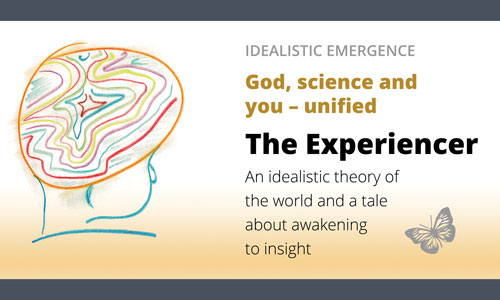We now have a world that is entirely idealistic, i.e. mental imaginings in a universal spirit. I have talked about how the physical building blocks may have come into being in such a worldview through the mechanism of «idealistic emergence».
Everything else, also on a macro level and up to the very largest, has come into existence similarly – of course, because we are talking about the fundamental mechanism that drives everything.
We have a whole world. It is moving, changing, dynamic. Imaginary trillions of events and interactions happen continuously. What we must now fully understand is how these immensely complex dynamics work.
Here the natural sciences have come surprisingly short.
In this chapter, I show how everything that happens in the universe develops according to a few simple principles – the «laws of complexity». The startling thing is that these explain and control both material, abstract and subjective phenomena – i.e. everything that exists.
That is something the classical branches of science are not close to managing!
Today's worldview does not explain how conscious experience can arise from matter. It is called «The Hard Problem». If we turn it around, the problem disappears. Then conscious experiencing is all there is; everything else is notions and experiences in this consciousness. At the same time, the laws of nature that govern the universe must be re-understood.We are now seeking the mental laws that will create an entire universe. They must be able to explain everything we experience as material and physical, but also everything subjective and abstract.
At our disposal, we already have the laws of nature, which have been discovered and refined through hundreds of years of scientific effort.
The laws of nature describe how something behaves. Often, they are about something material, but they can also be applied to a representation of something, abstractions, as in mathematics – or something subjective, as in psychology and the social branches of science.
An example is when science says that «fields» control how particles and much else in nature behave. Fields are abstract, while particles are perceived material. The natural laws apply to both – at the same time in this case.
As I have already described, a field is probably not something in itself, but only a set of rules, mathematical laws etc., i.e. an abstraction. Many laws of nature are helpful abstractions that demonstrably say something about the material.
They can also say something about things we experience as non-material.
Recapture, for example, music – which occurs through oscillations in the air.
Music is also a large number of rules and laws about pitches, harmony, rhythm, etc. These music laws are independent of the material. You can produce music in countless ways: blowing into empty bottles, turning on wooden sticks, whistling, using a computer, writing notes on paper, etc.
Regardless, the same abstract rules apply to harmonies and rhythm.
All this can be described scientifically. The material and the abstract meet everywhere. One can describe or influence the other and vice versa.
This is by no means sensational.
The abstract laws of nature are derived from our experience of something material. It is an unbreakable marriage.
The problem arises when we try to explain how the material can result in, form, lead to abstractions and subjective experiences.
The laws of nature say nothing about what abstractions and subjective experiences are. They do not explain how experiences can arise from non-sensory matter. This mystery got its name, «The Hard Problem»1, which was launched by the philosopher David Chalmers around 1995.
Think of the experience you get when you see something yellow, the quality yellow, the quale yellow. We know that the experience of different colours corresponds to varying frequencies of light and subsequent signals in the brain.
The subjective and the material are thus connected in a causal relationship, even if we do not fully understand it. There is seemingly a mechanistic connection between the brain and subjective experiences.
Then, shouldn't also the abstract and subjective be explainable by the laws of nature?
The answer is no. Mechanisms tell nothing about what things are; they only explain a function. That is the fundamental problem of physicalism. We know how things work but not what they are.
The same is true of all three categories of phenomena in the universe.
What is an abstraction? What is matter, really? What is subjective experience?
Physicalists and materialists do not know. An overwhelming majority of today's researchers have no suggestions for answers.
Stanford physicist Andrei Linde, one of the researchers behind the theory of cosmic inflation, put it this way in 1998 (ref2):
But let us remember that our knowledge of the world begins not with matter but with perceptions. I know for sure that my pain exists, my «green» exists, and my «sweet» exists. I do not need any proof of their existence, because these events are a part of me; everything else is a theory. Later we find out that our perceptions obey some laws, which can be most conveniently formulated if we assume that there is some underlying reality beyond our perceptions. This model of material world obeying laws of physics is so successful that soon we forget about our starting point and say that matter is the only reality, and perceptions are only helpful for its description.
We experience matter and fully believe in this perception. We develop laws of nature from the perceived matter, which we then try to use to explain the cause of the original experience.
This is circular argumentation. It is impossible.
Physicalism as a concept is and will always be wrong.
